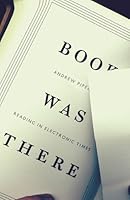
## Metadata
- Author: [[Andrew Piper ]]
- Full Title: Book Was There
- Category: #books
## Highlights
- The study of the book’s past has thankfully, and perhaps not unsurprisingly, undergone a renaissance of late. Once relegated to the academic backwaters known as “publishing history,” it is now at the forefront of numerous different disciplines. There are multivolume handbooks on the history of the book in the West, in the world, in general, and individually by country.6 There are centers for the study of the book in Edinburgh, Princeton, Toronto, and Hong Kong, and “book arts” has become a popular new graduate degree. There is nothing like a sense of demise to spur our attention. ([Location 109](https://readwise.io/to_kindle?action=open&asin=B009D17FZ0&location=109))
- If books are essentially vertebral, contributing to our sense of human uniqueness that depends upon bodily uprightness, digital texts are more like invertebrates, subject to the laws of horizontal gene transfer and nonlocal regeneration. They, like jellyfish or hydra polyps, always elude our grasp in some fundamental sense. ([Location 170](https://readwise.io/to_kindle?action=open&asin=B009D17FZ0&location=170))
- How can we hold, and hold on to, our digital texts today? It is not surprising that one of the most canonized pieces of new media art is Camille Utterback and Romy Achituv’s Text Rain (fig. 1.5), where letters rain down a screen and come to rest on projections of viewers’ open hands, one of many new electronic works that take the hand as their conceptual starting point.17 Text Rain is a potent reminder of the way the digital, at least in English, is named after the hand’s component parts. ([Location 304](https://readwise.io/to_kindle?action=open&asin=B009D17FZ0&location=304))
- For Augustine, the book’s closedness—that it could be grasped as a totality—was integral to its success in generating transformative reading experiences. Digital texts, by contrast, are radically open in their networked form. They are marked by a very weak sense of closure. ([Location 316](https://readwise.io/to_kindle?action=open&asin=B009D17FZ0&location=316))
- Open books can be measured by the sliding scale of pages past and future, like steps, just off to the side of the page. What lies after the digital page? An abyss. ([Location 347](https://readwise.io/to_kindle?action=open&asin=B009D17FZ0&location=347))
- With my e-book, I no longer pause over the slight caress of the almost turned page—a rapture of anticipation—I just whisk away. Our hands become brooms, sweeping away the alphabetic dust before us. ([Location 373](https://readwise.io/to_kindle?action=open&asin=B009D17FZ0&location=373))
- the meaning of reading lies in the oscillatory rhythms of the opening and closing hand. ([Location 448](https://readwise.io/to_kindle?action=open&asin=B009D17FZ0&location=448))
- it was Pindar who first equated writing with building (as in his sixth Olympic ode: “As when we contrive a stately mansion, supporting on golden pillars the well-built portal of the edifice, we will construct the hymn”). ([Location 495](https://readwise.io/to_kindle?action=open&asin=B009D17FZ0&location=495))
- When my son comes home today, he will play with the computer. Then he will go and do his homework, where he will use books for his reading, writing, and math exercises. My daughter, who is still in preschool, will simulate this process in reverse, playing with her notebooks, while the computer is still very much work for her. My hope is that these two categories, work and play, will remain as interwoven throughout their lives as the instruments that they use to engage in them, the book and the computer. I hope they are afforded the advantages of both, and that they pass on those advantages to others. My real hope, though, is that when it comes time to learn how these two very different instruments work (and play), I can send them to just one camp. ([Location 2153](https://readwise.io/to_kindle?action=open&asin=B009D17FZ0&location=2153))